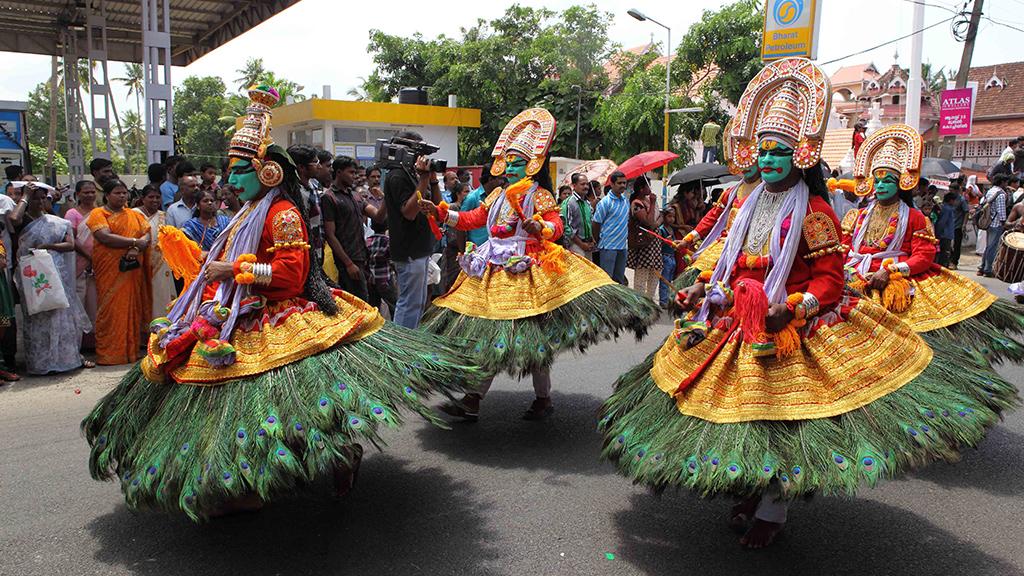Chief Minister Pinarayi Vijayan and superstar Mammootty launched the ceremonial annual pageantry that showcases the best of Kerala's culture.

A scene from Athachamayam procession held in Thripunithura. Photo: Kerala Tourism.
The ceremonial annual Athachamayam procession involving scores of traditional art forms, floats, and tableaus was held at Thripunithura on the outskirts of Kochi on Sunday, 20 August. It marked the beginning of the 10-day-long harvest festival of Onam in Kerala.
Scores of tourists from in and outside the country flocked to Tripunithura, the seat of the erstwhile princely state of Kochi, to witness the colourful pageantry, which was organised in a way showcasing the best of Kerala’s cultural traditions.
Hundreds of folk artists and musicians formed part of the procession, which was organised with traditional gaiety and splendour.
Thousands of people took part in it by raising placards carrying the messages of Onam: Unity, peace, and co-existence among people.
Malayalam superstar Mammootty flagged off the annual procession in the presence of Chief Minister Pinarayi Vijayan and several other dignitaries at 9 am at Atham Nagar in the crowded Tripunithura suburbs. There was a lot of excitement as the chief minister and the superstar attended the event.
This year, the gala event with splendour was organised strictly following green protocol.
Tripunithura municipal vice-chairman KK Pradeep Kumar told South First that the organisers ensured the procession was plastic-free and eco-friendly. There were also arrangements to quickly remove and scientifically process the garbage after the event.
After lighting the traditional lamp at the inaugural event, Vijayan said the secular nature of the celebrations should be upheld even in the current times as it was done when the erstwhile kingdom of Kochi held the festivities.
He said that even back then, Karingachira Kathanar, who represented the Christian community, Nettoor Thangal, representing the Muslim community, and Chembil Arayan, representing the fisherfolk, along with the royal families, were part of the Athachamayam celebrations.
He said that the light and message of secularism, brotherhood and peace projected by Tripunithura, once the capital of the erstwhile kingdom of Kochi, needed to spread across the country to counter the darkness of communalism, communal riots and racism.
Vijayan also said that the secular nature of Onam showed the unity of minds beyond caste, creed, and religion.
Thousands, across all age groups and from all walks of life, watched the colourful procession, which was given a rhythmic touch by the chendamelam and panchavadyam performances by percussionists.
Various folk art forms like Theyyam, Kolkali, Mayilattam, Ammankudam, and Pulikkali, and classical art forms like Kathakali added colour to the Athachamayam procession.
Many lined up along the procession route to witness the festivities. They said rain, natural disasters, and the Covid-19 pandemic had played spoilsport over the last few years, when the event could not be held properly.
“This year, it is on a Sunday, so we can come and watch it in person instead of on TV. Let’s hope it does not rain,” they said.
In the days of kings, the Maharaja of Kochi used to participate in the procession from Tripunithura to the Vamanamoorthy temple at Thrikkakara.
According to legends, the festival is celebrated to welcome King Mahabali, whose spirit is believed to visit Kerala at the time of Onam to see his subjects.
Some historians say the Maharaja of erstwhile Cochin organised the first Athachamayam to celebrate his victory in the Battle of Kochi (1504). The parade was said to connect with the masses and flaunt the kingdom’s military might.
Another story is that after King Cheraman Perumal, who ruled Kerala from Kodungallur, divided the kingdom, there were about 56 vassals. The rulers of these areas rarely gathered, except for an annual event at Thrikkakara’s Lord Vamana temple, adorning traditional attire. The procession known as Athachamayam, symbolising the kings’ journey to the temple, took place in each province.
In 1949, Athachamayam was temporarily stopped for the merging of the Travancore-Cochin kingdoms to form the short-lived Thiru-Kochi state.
The parade resumed in all its glory in 1961 when Onam became a mass festival in Kerala.
The procession, which used to start from Hill Palace, now starts from Attam Nagar, near the high school ground, and ends there.
A three-day ritual precedes the royal Athachamayam. The royal town crier arrives in the village on an elephant, beats the drum to get the villagers’ attention, and proceeds to announce the start of the rituals.

May 14, 2024

May 14, 2024

May 14, 2024

May 14, 2024

May 14, 2024

May 14, 2024